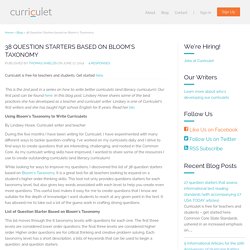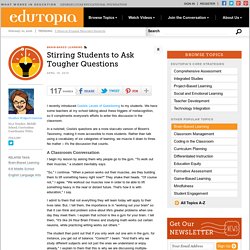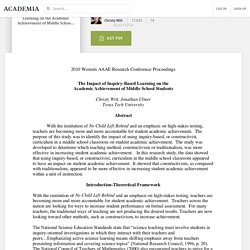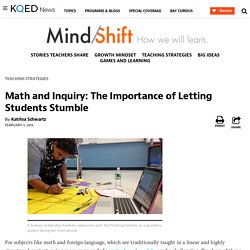

Costa and Blooms. Costas Levels of Thinking and Questioning. WMS AVID Video Lesson #2: Costas Levels of Questioning. Costa's levels of questioning. Levels of Questioning. Levels of Questioning. How to Spark Curiosity in Children Through Embracing Uncertainty. In the classroom, subjects are often presented as settled and complete. Teachers lecture students on the causes of World War I, say, or the nature of matter, as if no further questioning is needed because all the answers have been found. In turn, students regurgitate what they’ve been told, confident they’ve learned all the facts and unaware of the mysteries that remain unexplored. Without insight into the holes in our knowledge, students mistakenly believe that some subjects are closed. They lose humility and curiosity in the face of this conceit.
But our collective understanding of any given subject is never complete, according to Jamie Holmes, who has just written a book on the hidden benefits of uncertainty. He wants students to grapple with uncertainty to spark their curiosity and better prepare them for the “real world,” where answers are seldom clear-cut or permanent. “We’re much more certain about facts than we should be,” Holmes said. Assign projects that provoke uncertainty. 38 Question Starters based on Bloom’s Taxonomy - Curriculet. Curriculet is free for teachers and students.

Get started here. This is the 2nd post in a series on how to write better curriculets (and literacy curriculum). Our first post can be found here. In this blog post, Lindsey Howe shares some of the best practices she has developed as a teacher and curriculet writer. Lindsey is one of Curriculet’s first writers and she has taught high school English for 8 years. Using Bloom’s Taxonomy to Write Curriculets By Lindsey Howe, Curriculet writer and teacher During the five months I have been writing for Curriculet, I have experimented with many different ways to tackle question-crafting. AVID / Costa's Level of Questioning. Costas Flipbook. Costa's Levels of Thinking all. Tips To Have Students Ask Better Questions. Stirring Students to Ask Tougher Questions. I recently introduced Costa's Levels of Questioning to my students.

We have some teachers at my school talking about these triggers of metacognition, so it compliments everyone's efforts to enter this discussion in the classroom. In a nutshell, Costa's questions are a more staccato version of Bloom's Taxonomy, making it more accessible to more students. Rather than talk using a vocabulary of six categories of learning, we muscle it down to three. No matter -- it's the discussion that counts. A Classroom Conversation I begin my lesson by asking them why people go to the gym. "So," I continue. I admit to them that not everything they will learn today will apply to their lives later. The student then point out that if you only work out one arm in the gym, for instance, you get out of balance.
This is when I tell them about Costa's Levels of Questioning. Levels of Thinking Level I: Input At this point, if it's eighth grade, I recite The Preamble. Level II: Process Level III: Output. How to use Costa's level of thinking for Student Led Discussions. Teaching Higher Order Thinking Skills In Middle School. Stick Pick Tutorial. Pink Fluffy Unicorns Dancing On Rainbows. The Impact of Inquiry-Based Learning on the Academic Achievement of Middle School Students.
2010 Western AAAE Research Conference Proceedings270Due to this emphasis, teachers then struggle between ―the desire to cover a lot of material and the necessity of using more time-consuming methods that allow students to construct meaning from their lessons,‖ stated Jay McTighe, an education consultant and cocrea tor of the Understand byDesign program (Franklin, 2001, p. 2).

What Is Genius Hour? - What Is Genius Hour?

By TeachThought Staff Genius hour is an approach to learning where students are guided by their own interests, background knowledge, and curiosity to learn. From the outside looking in, it is less organized, less formal, and less standardized than traditional learning. Genius hour is truly “open-ended” learning characterized by student self-direction, passion-based learning, inquiry, and autonomy. In public education, genius hour can be thought of as a response to rigid, test-driven, and “achievement-focused” climate that testing-based model of school improvement has encouraged in schools over the two or three decades.
It has several unique characteristics that separate it from other approaches to education. Characteristics Of Genius Hour The image above provides 10 characteristics and 10 non-characteristics of genius hour. Where the Wonders of Learning Never Cease. Math and Inquiry: The Importance of Letting Students Stumble. For subjects like math and foreign language, which are traditionally taught in a linear and highly structured context, using more open-ended inquiry-based models can be challenging.

Teachers of these subjects may find it hard to break out of linear teaching style because the assumption is that students can’t move to more complicated skills before mastering basic ones. But inquiry learning is based on the premise that, with a little bit of structure and guidance, teachers can support students to ask questions that lead them to learn those same important skills — in ways that are meaningful to them. This model, however, can be especially hard to follow in public school classrooms tied to pre-set curricula. Science Leadership Academy, which has an established track record as an inquiry-based school, has just opened a second campus in Philadelphia called the Beeber school, whose teachers are still adapting to the inquiry model. Katrina Schwartz. Inquiry-Based Lesson Plans. Inquiry Learning Student understanding is the central focus of inquiry learning.

Students actively participate in inquiry learning experiences by developing questions and investigating to find solutions. Teachers facilitate learning as students engage in active problem solving, the construction of meaning and the communication of new understandings to students, teachers or other important adults. Teachers guide student learning by selecting, designing and planning learning tasks, asking probing questions, observing students at work to identify misconceptions and planning follow up experiences.